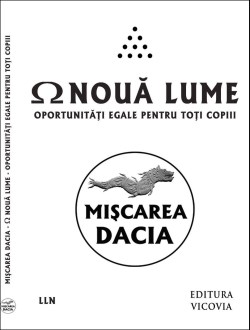The Holographic Principle

The Holographic Principle
“The holographic principle is a property of quantum gravity and string theories which states that the description of a volume of space can be thought of as encoded on a boundary to the region—preferably a light-like boundary like a gravitational horizon. String theory admits a lower dimensional description in which gravity emerges from it in what would now be called a holographic way. In a larger and more speculative sense, the theory suggests that the entire universe can be seen as a two-dimensional information structure ‘painted’ on the cosmological horizon, such that the three dimensions we observe are only an effective description at macroscopic scales and at low energies. Cosmological holography has not been made mathematically precise, partly because the cosmological horizon has a finite area and grows with time. The holographic principle was inspired by black hole thermodynamics, which implies that the maximal entropy in any region scales with the radius squared, and not cubed as might be expected. In the caseof a black hole, the insight was that the informational content of all the objects which have fallen into the hole could be entirely contained in surface fluctuations of the event horizon. The holographic principle resolves the black hole information paradox within the framework of string theory.” – Wikipedia
Mythopoeic thought: a hypothetical stage of human thought prior to modern thought. Humanity did not think in terms of generalizations and impersonal laws. Instead, humans regarded each event as an act of will by some personal being. This is “Mythos” rather than “Logos” thinking, and events are explained by way of narratives accounting for the actions of spirits and gods. Abrahamism is mythopoeic, the narrative being entirely concerned with the Will of God, and of humans cooperating with, or defying, God’s will. God causes the “Flood” because he is angry, not because of an earthquake and subsequent tsunami (i.e. a wholly natural event).
The “bicameral” mental model proposed by Julian Jaynes asserts that before the rise of modern consciousness, human beings experienced auditory hallucinations in which the gods and spirits spoke to them (a condition not unlike schizophrenia). Naturally, these provided a mythopoeic, narratised version of reality, which remains very popular to this day since most people understand the world through stories rather than hard, logical analysis.
It has been claimed that the ancient Egyptians and Mesopotamians lived in a wholly mythopoeic world – and the same may be said of the Hebrews, Christians and Muslims. The latter three religions replaced polytheistic Mythos with a monotheistic Mythos, but all the Mythos rules and mentality remained in place.
The ancient Greeks were the first to offer a Logos rather than Mythos way forward. The pre-Socratic philosophers treated “God” as a kind of impersonal, abstract cosmic mind (a deist rather than theist approach i.e. God remote from us rather than personally interested in us). In time, this evolved into the scientific materialist view where God was replaced by a set of natural, inflexible laws of cause and effect.
For these intellectual Greeks, each event was seen not as an act of God’s will (contrast Muslims who, even today, think that Allah personally directs their RPG grenades i.e. it’s his will whether they hit their target or not, and has nothing to do with the laws of physics).
Logos thinking kills Mythopoeic thinking. Logos thinking is the basis of authentic consciousness, but, sadly, most people prefer the Mythos worldview. They are not truly conscious and in charge of their own destiny but instead remain strongly bicameral, believing that some sort of divine will is really in charge, to which they think they can pray to change the course of their lives. The whole concept of prayer is bicameral. It implies that a person can enter into direct communication with the gods, and even with the Creator of the Universe, by uttering a few ritual incantations (like magic!) and then pleading with the Creator for a few personal favours not to be conferred on others. Prayer is conceived as a kind of direct conversation between a human being and his Creator. It is thus exactly the same as bicameralism whereby a person imagines he hears the voice of God in his own head, giving him commands.
In the Logos view, this is insane. It’s not an exaggeration to say that most of humanity remains bicameral, prone to “magic” Mythopoeic thinking, and that they cannot be considered fully conscious and rational.
Mythos human beings vastly outnumber Logos human beings, which is why our world is the way it is. It’s a place of stories, illusions, delusions, hallucinations, emotions and sensations rather than reason, logic, science, mathematics and philosophy.
Stupid, emotional people always block rational progress. How on earth can anyone rationally deal with billions of Muslims, Christians and Jews who continue to believe in scientifically disproven fantasies? How can the planet possibly become enlightened when such people exist?
Vitalism: the belief that the functions of a living organism are due to a vital principle distinct from biochemical reactions; that the processes of life are not explicable by the laws of physics and chemistry alone; that life is self-determining. Vitalism invokes a vital principle: the “vital spark” or “élan vital” (sometimes equated with the soul or spirit).
In medicine, vitalism proposes that disease results from imbalances in the vital energies that distinguish living from non-living matter. In the West, in ancient times, these vital forces were associated with the four temperaments and humours (“sanguine”, “choleric”, “melancholic” and “phlegmatic”); in the East forces such as qi and prana are held of central importance and must be perfectly balanced. Any blockages must be removed. Vitalism in medicine is concerned with living energies while modern Western medicine is materialistic, reductionist and mechanistic. Western medicine sees a patient as a broken-down car in need of repair by a mechanic; vitalist medicine is much more concerned with mental energy, with the patient as a living organism not reducible to “spare parts”.
Nondualism: the Eastern belief that things which appear distinct are in fact not separate but belong to an underlying unity; thus it has much in common with Western monism. While monism holds that all phenomena actually belong to the same substance, nondualism asserts that different phenomena are inseparable or flowing into each other, and there is no hard demarcation line between them. Nevertheless, they are not the same as monism would contend they ultimately are. Zen Buddhism is nondualist while Advaita Hinduism is monist (because it contends that all phenomena are really Brahman).
Excerpt from The God Game
Mike Hockney











